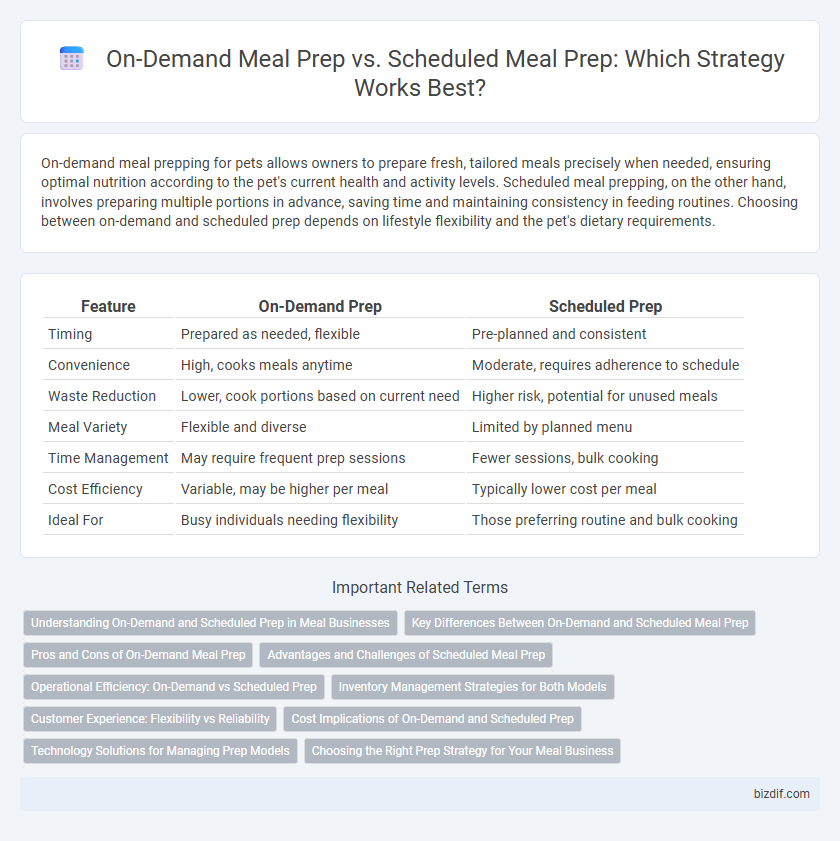On-demand meal prepping for pets allows owners to prepare fresh, tailored meals precisely when needed, ensuring optimal nutrition according to the pet's current health and activity levels. Scheduled meal prepping, on the other hand, involves preparing multiple portions in advance, saving time and maintaining consistency in feeding routines. Choosing between on-demand and scheduled prep depends on lifestyle flexibility and the pet's dietary requirements.
Table of Comparison
| Feature | On-Demand Prep | Scheduled Prep |
|---|---|---|
| Timing | Prepared as needed, flexible | Pre-planned and consistent |
| Convenience | High, cooks meals anytime | Moderate, requires adherence to schedule |
| Waste Reduction | Lower, cook portions based on current need | Higher risk, potential for unused meals |
| Meal Variety | Flexible and diverse | Limited by planned menu |
| Time Management | May require frequent prep sessions | Fewer sessions, bulk cooking |
| Cost Efficiency | Variable, may be higher per meal | Typically lower cost per meal |
| Ideal For | Busy individuals needing flexibility | Those preferring routine and bulk cooking |
Understanding On-Demand and Scheduled Prep in Meal Businesses
On-demand prep in meal businesses allows for customized meal preparation based on real-time orders, enhancing flexibility and reducing food waste by aligning production with actual demand. Scheduled prep involves preparing meals in advance according to a fixed timetable, optimizing kitchen efficiency and enabling bulk purchasing to reduce costs. Understanding these models helps businesses balance resource utilization, customer satisfaction, and operational scalability.
Key Differences Between On-Demand and Scheduled Meal Prep
On-demand meal prep offers flexibility by allowing meals to be prepared whenever needed, ideal for individuals with unpredictable schedules, while scheduled meal prep involves planning and cooking meals ahead of time for consistent weekly consumption. On-demand prep reduces food waste by using ingredients as required, whereas scheduled prep emphasizes efficiency and time-saving by batch cooking in bulk. Nutritional customization is often easier with on-demand prep, catering to immediate dietary needs, compared to scheduled prep that prioritizes routine and convenience.
Pros and Cons of On-Demand Meal Prep
On-demand meal prep offers flexibility by allowing individuals to prepare meals exactly when needed, reducing food waste and accommodating last-minute changes in schedule or appetite. However, it requires more frequent time investment and can be less efficient compared to batch cooking, potentially leading to inconsistent portion control and nutritional balance. This approach suits those with unpredictable routines but may challenge those seeking streamlined, bulk-prepared meals.
Advantages and Challenges of Scheduled Meal Prep
Scheduled meal prep maximizes efficiency by allocating specific times for cooking, reducing daily decision fatigue and ensuring consistent nutrition intake. This approach streamlines grocery shopping and portion control, aiding in budget management and minimizing food waste. Challenges include the need for flexibility to accommodate unexpected schedule changes and the risk of meals becoming less fresh if not consumed promptly.
Operational Efficiency: On-Demand vs Scheduled Prep
On-demand meal prep enables immediate response to fluctuating customer orders, reducing food waste and minimizing inventory costs, enhancing operational efficiency for businesses with variable demand. Scheduled prep allows for bulk ingredient purchasing and streamlined workflows, optimizing labor allocation and kitchen resource use for consistent order volumes. Balancing both methods can maximize efficiency by aligning production capacity with real-time sales trends and forecasted demand patterns.
Inventory Management Strategies for Both Models
On-demand prep requires real-time inventory tracking systems to manage fluctuating ingredient needs and minimize waste, relying heavily on just-in-time deliveries and flexible stock levels. Scheduled prep benefits from bulk purchasing and accurate forecasting, allowing for optimized storage solutions and reduced spoilage through planned usage cycles. Both models demand integrated inventory software to synchronize procurement, usage, and replenishment, ensuring efficient resource allocation tailored to operational tempo.
Customer Experience: Flexibility vs Reliability
On-demand meal prep offers customers flexibility by allowing them to order meals whenever needed, adapting to unpredictable schedules and lifestyle changes. Scheduled meal prep enhances reliability with consistent delivery times and menu planning, ensuring customers have meals ready without last-minute decisions. Balancing these options can improve customer satisfaction by catering to diverse preferences for spontaneity or routine.
Cost Implications of On-Demand and Scheduled Prep
On-demand meal prep often incurs higher costs due to last-minute ingredient purchases and expedited labor, increasing overall expenses. Scheduled meal prep benefits from bulk buying and streamlined workflows, reducing per-meal costs significantly. Businesses leveraging scheduled prep achieve better cost control and profit margins compared to on-demand services.
Technology Solutions for Managing Prep Models
Technology solutions for meal prepping offer versatile platforms that support both on-demand and scheduled prep models by integrating real-time order tracking, inventory management, and automated workflow systems. Advanced apps use AI algorithms to optimize ingredient purchasing and reduce waste, ensuring efficient meal preparation whether customers require instant meal assembly or pre-planned weekly deliveries. Cloud-based software facilitates seamless communication between kitchen staff and customers, enhancing accuracy and customization in meal prep services.
Choosing the Right Prep Strategy for Your Meal Business
On-Demand Prep offers flexibility by preparing meals as orders come in, ideal for businesses with variable demand and customized menus, while Scheduled Prep relies on batch cooking based on forecasted orders, reducing waste and optimizing ingredient sourcing. Analyze your customer ordering patterns, menu complexity, and storage capabilities to determine which prep strategy maximizes efficiency and maintains food quality. Integrating data from sales trends and inventory turnover helps tailor your meal prep approach, ensuring scalability and customer satisfaction in your meal business.
On-Demand Prep vs Scheduled Prep Infographic

 bizdif.com
bizdif.com